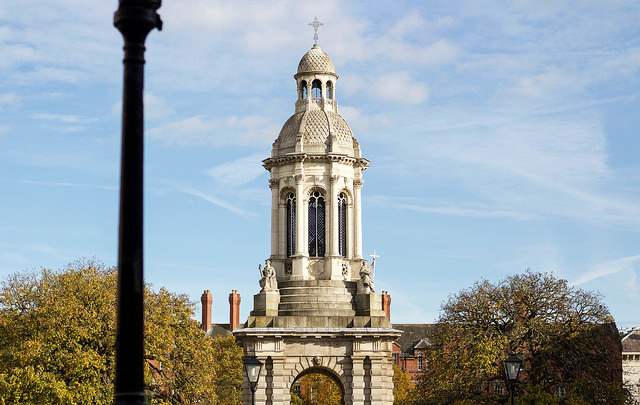Trinity scientists today put the Mercury Transit on display to the public as the planet moves across the face of the sun for the last time until 2032.
The viewing took place through a high-power microscope in Front Square, with the progress of Mercury’s pathway displayed in real time from locations around the world on a large screen.
Mercury will pass between the earth and the sun between 12:40 and 18:00 this evening, after sunset in Ireland. There only around 13 Mercury transits visible from Earth every century.
In a press statement, Joe McCauley, the senior experimental officer in Trinity’s School of Physics, said: “Mercury will appear as a block dot on the face of the Sun, much too small to without magnification. But the telescope, with a special solar filter, will let members of the public see what the Sun looks like and enable them to see the tiny planet moving through space across the vast face of our Sun.”
Prof Aline Vidotto, an assistant professor in astrophysics whose research at Trinity involves studying the interaction between exoplanets and their host stars, said: “Today, transits of planets orbiting other stars are used to find new planetary systems. More than 4,000 exo-planets are known today, three-quarters of which were discovered using planetary transits.”
Transits such as these have for a long time been used to calculate the distance between the earth and the sun.
Both NASA and the European Space Agency will be streaming live images of Mercury’s transit from their spacecraft and telescopes. Astronomy Ireland has warned viewers not to use a telescope or binoculars to attempt to view the event due to the damage that sunlight can cause to the naked eye.
Earlier this year, a Trinity researcher led an international team of scientists to a major new discovery about how an exotic matter – plasma – behaves in the sun’s atmosphere, which could lead to the development of more efficient nuclear generators for humans.
Dr Eoin Carley, a postdoctoral researcher in Trinity and the Dublin Institute for Advanced Studies, was at the head of a collaborative effort between Irish and French researchers, who used radio telescopes and ultraviolet cameras on a NASA spacecraft to better understand how plasma behaves under the sun’s extreme heat.
Last year, Trinity astrophysicists mapped the Perseid meteor shower using the Irish Low Frequency Array (I-LOFAR) radio telescope in Birr Castle.
The team behind I-LOFAR intended to document the number of meteors per minute, how fast they are, their origination, and where they are going, using using radio antennae to observe reflections of aeronautical radar off the plasma trail of each meteor.







